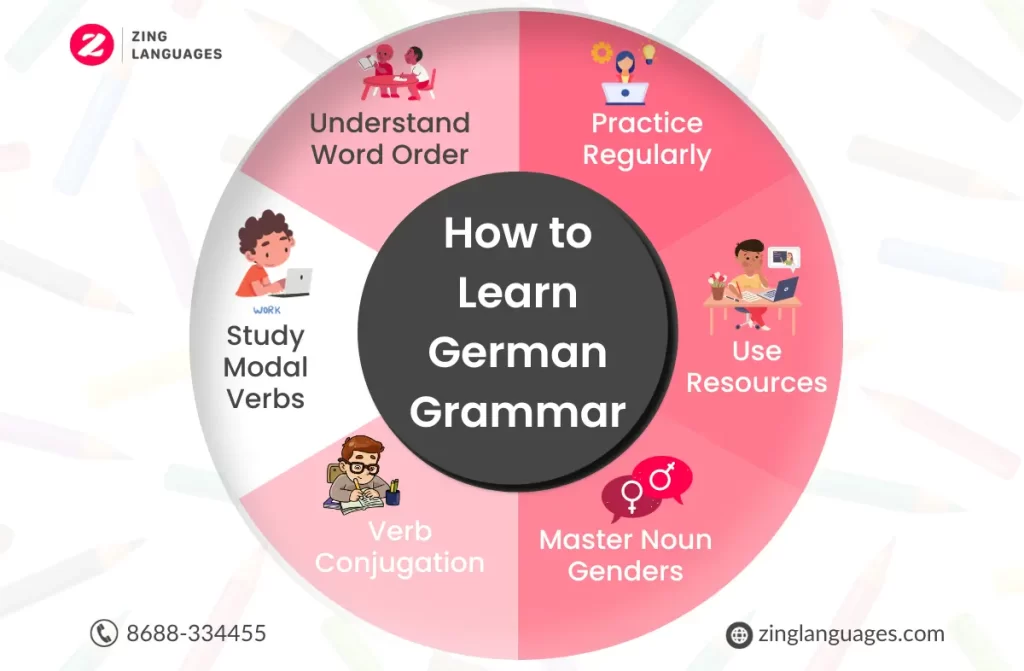Learning how to learn German grammar is an essential step on your journey to becoming proficient in the language. While how to improve German grammar may initially appear complex, breaking it down into manageable concepts and regular practice can make the process accessible and rewarding.
In this comprehensive beginner’s guide, we will delve into the fundamental aspects of learning how to learn German grammar, which will provide a solid foundation for your language learning journey.
How to Learn German Grammar: A Beginner’s Guide
Embarking on your German language journey is an exciting adventure, and mastering its grammar is a crucial milestone. In this comprehensive guide, we will break down the intricacies of German grammar into digestible concepts, offering practical tips and insights to help beginners build a strong foundation.
Whether you’re learning for travel, business, or personal enrichment, this guide will pave the way for effective communication and fluency in the German language.
Read Also Online German A1 Course.

The German Alphabet
Before diving into grammar rules, let’s start with the basics the German alphabet. The German alphabet consists of 26 letters, similar to the English alphabet, with four additional characters: Ä, Ö, Ü, and ß (Eszett). Understanding the alphabet is crucial as it forms the building blocks for pronunciation and spelling in German.
Here’s an overview of the German alphabet:
A, B, C, D, E, F, G, H, I, J, K, L, M, N, O, P, Q, R, S, T, U, V, W, X, Y, Z Ä, Ö, Ü, ß (Eszett)
Learning to pronounce these letters correctly will help you communicate effectively in German while how to learn German grammar.
Nouns and Gender
In German, all nouns (people, places, objects) have grammatical gender—masculine, feminine, or neuter. Unlike English, where gender is not a consideration for nouns, German nouns must be accompanied by the appropriate articles (definite or indefinite) and adjectives, which depend on their gender.
Let’s look at a general guideline for gender assignment:
- Masculine (der): Words like “der Mann” (the man), “der Tisch” (the table).
- Feminine (die): Examples include “die Frau” (the woman), “die Blume” (the flower).
- Neuter (das): Words like “das Kind” (the child), “das Buch” (the book).
The gender of nouns may appear arbitrary initially, but with practice, you’ll develop an intuition for it. Consistent practice and exposure to the language will help you master this aspect of how to learn German grammar.
Definite and Indefinite Articles
Articles, similar to “the” and “a/an” in English, change in German based on the gender and case of the noun they accompany. German has definite articles (specific) and indefinite articles (non-specific):
Definite Articles: These are used when referring to a specific noun.
- Masculine: der Mann (the man)
- Feminine: die Frau (the woman)
- Neuter: das Kind (the child)
Indefinite Articles: These are used when referring to a non-specific noun.
- Masculine: ein Mann (a man)
- Feminine: eine Frau (a woman)
- Neuter: ein Kind (a child)
Understanding when to use definite or indefinite articles is crucial for constructing grammatically correct sentences in German and how to improve German grammar.
Plural Nouns
Forming plurals in German involves changing the endings of nouns. While there are no universal rules, some general guidelines can help you understand plural noun formation:
- Most masculine and neuter nouns add -e to the end: “der Tisch” (the table) → “die Tische” (the tables).
- Many feminine nouns add -n: “die Blume” (the flower) → “die Blumen” (the flowers).
- Some nouns change their vowels: “der Mann” (the man) → “die Männer” (the men).
- A few nouns add -er: “der Lehrer” (the teacher) → “die Lehrer” (the teachers).
Plural forms can be irregular, so it’s essential to familiarize yourself with common patterns and exceptions while improving German Language Proficiency Tests.
Sentence Structure
German sentence structure typically follows a Subject-Verb-Object (SVO) pattern in main clauses, similar to English. For example:
- English: “I (subject) eat (verb) pizza (object).”
- German: “Ich (subject) esse (verb) Pizza (object).”
However, in some cases, word order changes for emphasis or in subordinating clauses. It’s essential to grasp these nuances as you progress in your German studies to convey your message accurately while how to learn German grammar.
Read Also German Writing Skills.
Verb Conjugation
Verbs in German course change based on the subject and tense. Unlike English, where verb conjugations are relatively straightforward, German verbs have more variations. Here’s an overview of present tense conjugation for regular verbs:
- Ich (I) – -e: Ich spiele (I play).
- Du (You) – -st: Du spielst (You play).
- Er/Sie/Es (He/She/It) – -t: Er spielt (He plays).
- Wir (We) – -en: Wir spielen (We play).
- Ihr (You all) – -t: Ihr spielt (You all play).
- Sie (They) – -en: Sie spielen (They play).
Irregular verbs have unique conjugations, so it’s essential to learn them individually. Regular practice with verbs will help you build fluency in conversation and writing while how to learn German grammar.
Modal Verbs
Modal verbs in German, such as “können” (can), “müssen” (must), and “wollen” (want), are used to express abilities, obligations, and desires. These modal verbs are often combined with infinitive verbs to convey specific meanings. For instance:
- Ich kann (can) Deutsch sprechen (speak German).
- Du musst (must) die Hausaufgaben machen (do homework).
- Er will (wants) heute Abend ins Kino gehen (go to the cinema
Conclusion
In conclusion, embarking on the journey of how to learn German grammar as a beginner is an exciting and rewarding endeavor. By mastering the fundamentals such as gender, articles, plurals, sentence structure, verb conjugation, and modal verbs, you’ll lay a strong foundation for becoming proficient in the language. Practice and persistence are your allies in this linguistic adventure.
Check out German Numbers Pronunciation.
Also check French Vs German Language.





